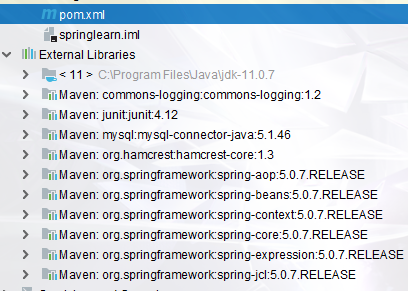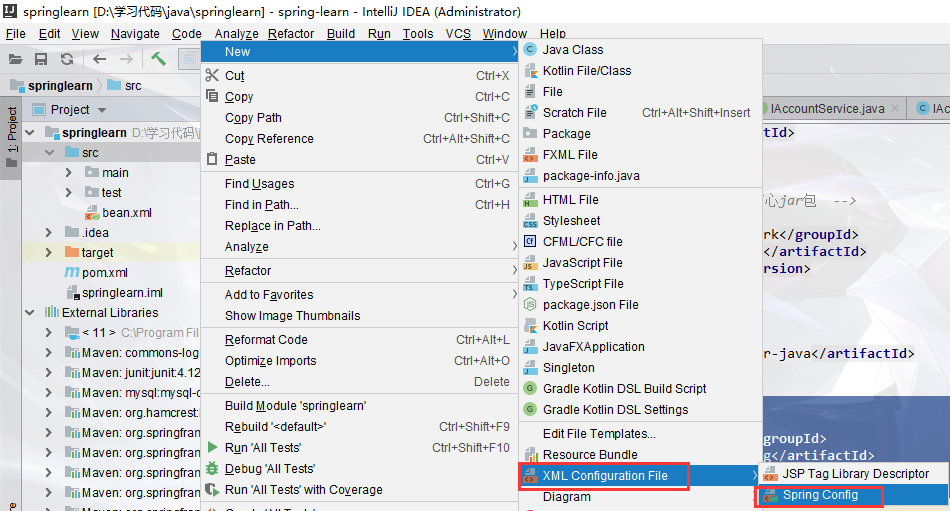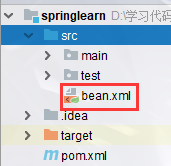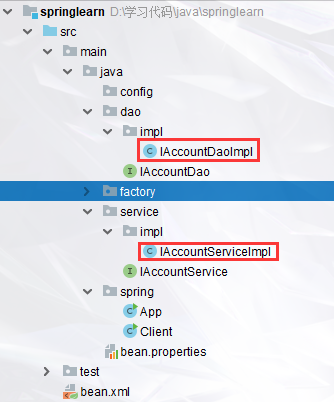Spring,Spring,Spring,天天用,但是对她太过缺乏“深入”的了解,今天思虑良久,下定决心,我要好好“深入的”了解一下她。
Spring是一个架构性的框架:也就是改变代码结构的框架;
1.学习环境的准备
大部分教学视频是使用老掉牙Ecliplse教学Spring的,但是我TM是真的不想用Ecliplse,虽然我电脑上有Ecliplse...如果你要选择Ecliplse那么你可以跟着视频老老实实创建java项目--->导入jar包--->创建XML配置文件,完成spring学习环境的搭建;但是下面我要说的是我是如何使用IDEA开始Spring的学习的:


创建完maven项目之后,在pom.xml文件里面添加如下依赖:
<!-- spring-context:导入spring核心jar包 --> <dependency> <groupId>org.springframework</groupId> <artifactId>spring-context</artifactId> <version>5.0.7.RELEASE</version> <!-- <scope>test</scope>--> </dependency> <!-- 导入日志jar包--> <dependency> <groupId>commons-logging</groupId> <artifactId>commons-logging</artifactId> <version>1.2</version> </dependency> </dependencies>
然后,你会发现项目依赖库下面增加了许多spring相关jar:

然后我们在项目资源文件夹src下面创建spring的配置文件:


这样你就可以愉快的开始spring学习之旅了....简单吧
2.IOC入门案例
2.1在bean.xml里面添加如下配置:
前提是下面的类已经在对应的路径下创建了:
<!-- bean:来映射一个类 id:是bean的唯一标识,如果没有指定则默认将会以类名作为标识 class:映射类的全路径 IOC容器管理默认是单例 --> <bean id="accountService" class="main.java.service.impl.IAccountServiceImpl"></bean> <bean id="accountDao" class="main.java.dao.impl.IAccountDaoImpl"></bean>

2.2获取Spring的核心容器,并且根据bean的id获取对象
创建一个类,书写如下代码:
public class Client { public static void main(String[] args) { /** * 获取Spring的核心容器,并且根据bean的id获取对象 * * ApplicationContext:是BeanFactory的孙子接口,创建对象的时候采取的是立即加载的策略.(读取完XML配置文件之后,xml里面所有的bean对象就已经全部创建完成了) */ // 1.获取容器 ApplicationContext context = new ClassPathXmlApplicationContext("bean.xml"); // 2.根据bean的id获取对象 IAccountService iAccountService=(IAccountService)context.getBean("accountService"); IAccountDao accountDao = context.getBean("accountDao", IAccountDao.class); System.out.println(iAccountService); System.out.println(accountDao); } }
补充:ApplicationContext子类:
/* * ApplicationContext子类: * -----ClassPathXmlApplicationContext: * 她是通过读取类路径下的配置文件创建spring容器;要求配置文件在类路径下 * -----FileSystemXmlApplicationContext * 她是通过读取文件系统中的配置文件创建spring容器;要求配置文件在文件系统中即可 */
2.3懒加载
如果我ლ❥们xml文件里面bean非常多,在创建容器的时候我们瞬间初始化那么多bean可能会导致卡顿,这个时候我们可以在xml文件里面按照下图:就能实现在调用getBean时才初始化:

2.4懒加载容器
如果我们不想通过上面的配置实现懒加载,下面的代码也可以实现在getBean时才创建对象:
public class Client { public static void main(String[] args) { /** * 获取Spring的核心容器,并且根据bean的id获取对象 * * ApplicationContext:是BeanFactory的孙子接口,创建对象的时候采取的是理解加载的策略.(读取完XML配置文件之后,xml里面所有的bean对象就已经全部创建完成了) * BeanFactory:是springIoc的顶层接口,创建bean对象时,采用延迟加载的策略(当真正要从容器中获取对象时,才会创建,读完配置文件并不创建) */ // 1.获取容器 ApplicationContext context = new ClassPathXmlApplicationContext("bean.xml"); // 2.获取对象 IAccountService iAccountService = (IAccountService) context.getBean("accountService"); IAccountDao accountDao = context.getBean("accountDao", IAccountDao.class); System.out.println(iAccountService); System.out.println(accountDao); // 1.加载配置文件 Resource resource = new ClassPathResource("bean.xml"); // 2.获取容器 BeanFactory beanFactory = new XmlBeanFactory(resource); // 3.获取对象 IAccountService accountService = beanFactory.getBean("accountService", IAccountService.class); } }
2.5bean对象的三种创建方式
<?xml version="1.0" encoding="UTF-8"?> <beans xmlns="http://www.springframework.org/schema/beans" xmlns:xsi="http://www.w3.org/2001/XMLSchema-instance" xsi:schemaLocation="http://www.springframework.org/schema/beans http://www.springframework.org/schema/beans/spring-beans.xsd" ><!--default-lazy-init="true" :设置所有的bean为懒加载 --> <!--spring管理bean对象细节: bean标签:来映射一个类 作用:让spring帮我们读取配置之后创建对象 属性: id:是bean的唯一标识,如果没有指定则默认将会以类名作为标识 class:映射类的全路径 factory-method:指定创建bean对象的方法; factory-bean:指定创建bean对象的工厂bean的id bean对象的三种创建方式: 1.通过调用默认构造函数创建bean对象 (常用) 在默认情况下我们在spring配置文件中写了一个bean标签,并提供了class属性,spring就会调用默认构造方法创建对象 2.通过静态工厂创建bean对象 工厂类中提供一个静态方法,可以返回一个我们要获取的类的对象 public class BeanFactory { public static IAccountService getBean1() { return new IAccountServiceImpl(); } } 3.通过实例工厂创建bean对象 工厂类中提供一个非静态方法,可以返回一个我们要获取的类的对象 public class BeanFactory { public IAccountService getBean2() { return new IAccountServiceImpl(); } } --> <!-- 1.默认方式创建对象:--> <bean id="accountService" class="main.java.service.impl.IAccountServiceImpl"></bean> <!-- 2.静态工厂创建对象 id:bean的id class:工厂类 factory-method:工厂类里面生成bean对象的方法(静态方法) --> <bean id="staticFactory" class="main.java.factory.BeanFactory" factory-method="getBean1"></bean> <!-- 3.实例工厂创建对象 factory-bean:指定工厂bean的id factory-method:指定工厂类里面生产bean对象的方法(非静态方法) --> <bean id="instanceFactory" class="main.java.factory.BeanFactory"></bean> <bean id="instanceFactoryBean" factory-bean="instanceFactory" factory-method="getBean2"></bean> </beans>
public class CreatBeanTest { public static void main(String[] args) { ApplicationContext context = new ClassPathXmlApplicationContext("bean.xml"); // 1.默认构造函数创建对象,获取方法 IAccountService accountService = context.getBean("accountService", IAccountService.class); System.out.println(accountService);//main.java.service.impl.IAccountServiceImpl@17f7cd29 // 2.静态工厂创建对象,获取方法 IAccountService accountService1 = context.getBean("staticFactory", IAccountService.class); System.out.println(accountService1);//main.java.service.impl.IAccountServiceImpl@7d8704ef // 3.实例工厂创建对象,获取方法 IAccountService accountService2 = context.getBean("instanceFactoryBean", IAccountService.class); System.out.println(accountService2);//main.java.service.impl.IAccountServiceImpl@17f7cd29 } }
2.6bean对象的作用范围:
<!-- bean对象的作用范围: 它是可以通过配置的方式来指定的。 配置的属性:bean标签的scope属性 属性的取值: singleton:单例的。默认值 prototype:多例的. request:WEB项目中,Spring创建一个Bean的对象,将对象存入到 request域中。 session:WEB项目中,Spring创建一个Bean的对象,将对象存入到 session域中。 global-session:WEB项目中,应用在 Portlet环境,如果没有Portlet环境那么 global-session相当于session --> <bean id="accountService" class="main.java.service.impl.IAccountServiceImpl" scope="prototype"></bean>
2.7bean对象的生命周期:
<!-- bean对象的生命周期: 单例对象 出生:容器创建对象出生 活着:只要容器存在,对象就一直可用。 死亡:容器销毁,对象消亡。 多例对象 出生:每次使用时,容器会为我们创建对象。 活着:只要对象在使用过程中,就一直活着。 死亡:当对象长时间不用,并且也没有其他对象引用时,由java的垃圾回收器回收. --> <bean id="singleton_accountService" class="main.java.service.impl.IAccountServiceImpl" scope="singleton" init-method="init" destroy-method="destory"></bean> <bean id="prototype_accountService" class="main.java.service.impl.IAccountServiceImpl" scope="prototype" init-method="init" destroy-method="destory"></bean>
public class IAccountServiceImpl implements IAccountService { IAccountDao iAccountDao=new IAccountDaoImpl(); public IAccountServiceImpl(){ System.out.println("对象创建了!!!"); } public void init(){ System.out.println("对象初始化了"); } public void destory(){ System.out.println("对象销毁了了"); } @Override public void saveAccount() { iAccountDao.save(); } }
public class _05LifecycleTest { public static void main(String[] args) { // 1.获取容器 ClassPathXmlApplicationContext context = new ClassPathXmlApplicationContext("bean_lifecycle.xml"); // 2.获取对象 IAccountService accountService1 = context.getBean("singleton_accountService", IAccountService.class); System.out.println(accountService1); IAccountService accountService2 = context.getBean("prototype_accountService", IAccountService.class); System.out.println(accountService2); // 3.销毁容器 context.close(); } }
3.DI依赖注入
3.1介绍两种注入类型
<?xml version="1.0" encoding="UTF-8"?> <beans xmlns="http://www.springframework.org/schema/beans" xmlns:xsi="http://www.w3.org/2001/XMLSchema-instance" xsi:schemaLocation="http://www.springframework.org/schema/beans http://www.springframework.org/schema/beans/spring-beans.xsd"> <!-- Spring的依赖注入 注入的方式:只有3中(今天只涉及两种) 第一种方式:通过构造函数注入 第二种方式:通过set方法注入 注入的内容: 第一类:基本类型和String类型 第二类:其他的bean类型 第三类:复杂类型(集合类型) --> <!-- 第一种:使用构造函数注入: 该方式要求对应的类必须有对应的带参构造方法 涉及的标签: constructor-arg 该标签是写在bean标签内部的子标签 标签的属性: type:指定要注入的参数在构造函数中的类型 index:指定要注入的参数在构造函数的索引位置 name:指定参数在构造函数的中的名称 value:指定注入的数据内容,他只能指定基本类型数据和String类型数据 ref:指定其他bean类型数据。写的是其他bean的id。其他bean指的是存在于spring容器中的bean。 --> <!-- 1.构造方法注入--> <bean id="accountService" class="main.java.service.impl.IAccountServiceImpl" > <constructor-arg name="name" value="李沁"></constructor-arg> <constructor-arg name="age" value="18"></constructor-arg> <constructor-arg name="birthday" ref="birthday"></constructor-arg> </bean> <bean id="birthday" class="java.util.Date"></bean> <!-- 第二种:使用set方法注入常用 涉及的标签: property 该标签也是要写在bean标签内部的子标签 标签的属性: name:指定的是set方法的名称。匹配的是类中set后面的部分的全小写。 value:指定注入的数据内容,他只能指定基本类型数据和String类型数据 ref:指定其他bean类型数据。写的是其他bean的id。其他bean指的是存在于spring容器中的bean。 --> <!-- 2.set方法注入--> <bean id="accountService2" class="main.java.service.impl.IAccountServiceImpl" > <property name="name" value="李沁2"></property> <property name="age" value="17"></property> <property name="birthday" ref="birthday"></property> </bean> </beans>
public class IAccountServiceImpl implements IAccountService { private String name; private int age; private Date birthday; public IAccountServiceImpl(String name, int age, Date birthday) { this.name = name; this.age = age; this.birthday = birthday; } public void setName(String name) { this.name = name; } public void setAge(int age) { this.age = age; } public void setBirthday(Date birthday) { this.birthday = birthday; } public IAccountServiceImpl(){ System.out.println("对象创建了!!!"); } @Override public void saveAccount() { System.out.println(name+age+birthday); } }
public class _06DI { public static void main(String[] args) { // 1.获取容器 ClassPathXmlApplicationContext context = new ClassPathXmlApplicationContext("bean_DI.xml"); // 2.获取对象 IAccountService accountService1 = context.getBean("accountService", IAccountService.class); accountService1.saveAccount(); IAccountService accountService2 = context.getBean("accountService2", IAccountService.class); accountService2.saveAccount(); // 3.销毁容器 context.close(); } }
3.2 P名称空间注入:
<!-- 使用p名称空间注入 它的本质仍然是需要类中提供set方法,同时在配置文件中要导入p名称空间 --> <bean id="accountService3" class="main.java.service.impl.IAccountServiceImpl" p:name="李沁3"> </bean>

3.3特殊类型属性注入
public class CollectionsDI { private String [] strings; private List<String>myList; private Set<String> mySet; private Map<String,String>myMap; private Properties myProps; public void setStrings(String[] strings) { this.strings = strings; } public void setMyList(List<String> myList) { this.myList = myList; } public void setMySet(Set<String> mySet) { this.mySet = mySet; } public void setMyMap(Map<String, String> myMap) { this.myMap = myMap; } public void setMyProps(Properties myProps) { this.myProps = myProps; } public void print(){ System.out.println(Arrays.toString(strings)); System.out.println(myList); System.out.println(myMap); System.out.println(mySet); System.out.println(myProps); } }
<bean id="CollectionsDI" class="main.java.service.CollectionsDI" > <!-- 1.给数组注入数据--> <property name="strings"> <array> <value>args</value> <value>args</value> <value>args</value> </array> </property> <!-- 2.给List注入数据--> <property name="myList"> <list> <value>LIST</value> <value>LIST</value> <value>LIST</value> </list> </property> <!-- 3.给Set注入数据--> <property name="mySet"> <set> <value>SET</value> <value>SET</value> <value>SET</value> </set> </property> <!-- 4.给Map注入数据--> <property name="myMap"> <map> <entry key="001" value="map"></entry> <entry key="002"> <value>map注入方式2</value> </entry> </map> </property> <!-- 5.给Properties注入数据--> <property name="myProps"> <props> <prop key="url">http:www.baidu.com</prop> </props> </property> </bean>
public class _06DI { public static void main(String[] args) { // 1.获取容器 ClassPathXmlApplicationContext context = new ClassPathXmlApplicationContext("bean_DI.xml"); // 2.获取对象 CollectionsDI collectionsdi = context.getBean("CollectionsDI", CollectionsDI.class); collectionsdi.print(); /** [args, args, args] [LIST, LIST, LIST] {001=map, 002=map注入方式2} [SET1, SET2, SET3] {url=http:www.baidu.com} */ // 3.销毁容器 context.close(); } }
注意:上面xml文件里面bean标签内部结构相同的标签可以互换使用:
<!-- 1.给数组注入数据--> <property name="strings"> <list> <value>LIST</value> <value>LIST</value> <value>LIST</value> </list> </property> <!-- 2.给List注入数据--> <property name="myList"> <array> <value>args</value> <value>args</value> <value>args</value> </array> </property>
3.4注入时特殊符号处理

3.5注解注入
一,用于创建对象的注解:
/*** * 账号业务层实现类 * 原来在XML的配置 * <bean id="IAccountService_annotation" class="main.java.service.impl.IAccountService_annotationImpl" > * <property name="iAccountDao_annotation" ref="dao"></property> * </bean> * 上面原来在XML里面的配置现在可以使用下面的注解搞定: * 注解的分类 * 一,用于创建对象的: * @Component: * 作用:就相当于在spring的xml配置文件中写了一个bean标签。 * 属性: * value:用于指定bean的id。当不写时,默认值是当前类名,首字母改小写。例如:accountServiceImpl * 由此注解衍生的三个注解: * @Controller:一般用于表现层 * @Service:一般用于业务层 * @Repository:一般用于持久层 * 他们的作用以及属性和@Component的作用是一模一样的。他们的出现是spring框架为我们提供更明确的语义化来指定不同层的bean对象。 */ //@Component(value = "IAccountService_annotation") //@Service(value = "IAccountService_annotation") @Repository(value = "IAccountService_annotation") public class IAccountService_annotationImpl implements IAccountService_annotation { ... }
上面的代码就实现了将类IAccountService_annotationImpl 交给Spring容器作为组件管理,当然,前提是上面这个类要在Spring启动的时候被Spring扫描到,配置Spring的扫描路径是在spring的xml配置文件里添加如下代码:
<!--告知Spring创建容器时要扫描的包:这些包下面所有带有Spring注解的内容都会被加载到Spring容器里面--> <context:component-scan base-package="main.java.service"></context:component-scan> <context:component-scan base-package="main.java.dao"></context:component-scan>
二,用于注入数据的:
/** * 二,用于注入数据的: * @Autowired * 作用:自动按照类型注入。只要容器中有唯一的类型匹配,则可以直接注入成功。如果没有匹配的类型就报错。 * 如果有多个类型匹配时,会先按照类型找到符合条件的对象,然后再用变量名称作为bean的id,从里面继续查找,如果找到仍然可以注入成功,如果没有匹配的id,就报错 * 细节:当使用此注解注入时,set方法就可以省略了。 * 属性: * required:是否必须注入成功。取值是true(默认值)/false。当取值是true时,没有匹配的对象就报错。 * @Qualifier作用:在自动按照类型(@Autowired)注入的基础之上,再按照bean的id注入。在给类成员注入时,它不能够浊立使用。 * 属性: * value:用于指定bean的id。 * @Resource作用:直接按照bean的id注入。 * 属性: * name:用于指定bean的id。 * 以上3个注解,都只能用于注入其他bean类型,而不能注入基本类型和String。 * 用于注入基本类型和String类型的注解 */ //@Component(value = "IAccountService_annotation") //@Service(value = "IAccountService_annotation") @Repository(value = "IAccountService_annotation") public class IAccountService_annotationImpl implements IAccountService_annotation { //@Autowired //@Qualifier(value = "dao") @Resource(name = "dao") private IAccountDao_annotation iAccountDao_annotation; /* public void setiAccountDao_annotation(IAccountDao_annotation iAccountDao_annotation) { this.iAccountDao_annotation = iAccountDao_annotation; }*/ @Override public void saveAccount() { iAccountDao_annotation.save(); } }
@Value:
/** @Value作用:用于注入基本类型和String类型的数据。 属性: value:用于指定要注入的数据。它支持使用spring的el表达式。 spring的el表达式写法: ${表达式} **/ @Repository(value = "IAccountService_annotation") public class IAccountService_annotationImpl implements IAccountService_annotation { @Value("https://www.hao123.com/") public String url; @Value("${jdbc.driver}") private String driver; @Override public void saveAccount() { System.out.println(url);//https://www.hao123.com/ System.out.println(driver);//com.mysql.jdbc.Driver; iAccountDao_annotation.save(); } }
spring的el表达式的使用前提是:
1.我们要提前创建了相应的配置文件:

2.我们在spring的xml配置文件里面添加如下注解:
<!-- 告知Spring,properties配置文件的位置--> <context:property-placeholder location="dataBaseConfig.properties"></context:property-placeholder>
三,用于改变作用范围:
/** 三,用于改变作用范围: * @Scope * 作用:用于改变bean的作用范围。范围的取值和xml中的配置是一样的(单例:singleton;多例:prototype) * 属性: * value:用于指定范围。 **/ @Component(value = "IAccountService_annotation") @Scope("prototype")//多例(默认情况是单例) public class IAccountService_annotationImpl implements IAccountService_annotation { ... }
测试代码:
public static void main(String[] args) { ClassPathXmlApplicationContext context = new ClassPathXmlApplicationContext("bean_annotation.xml"); IAccountService_annotation annotation = context.getBean("IAccountService_annotation", IAccountService_annotation.class); IAccountService_annotation annotation2 = context.getBean("IAccountService_annotation", IAccountService_annotation.class); System.out.println(annotation==annotation2);//false }
四,和生命周期相关的:
/** * 四,和生命周期相关的: * @PostContruct * 作用:用于指定初始化方法。和配置文件中init-method属性是一样的 * @PreDestroy * 作用:用于指定销毁方法。和配置文件中destroy-method属性是一样的 */ @Component(value = "IAccountService_annotation") @Scope("singleton") public class IAccountService_annotationImpl implements IAccountService_annotation { @PostConstruct public void init(){ System.out.println("对象初始化了"); } @PreDestroy public void destory(){ System.out.println("对象销毁了"); } }
补充内容:
@Autowired图解

@Resource爆红?

Alt+Enter


最后项目pom.xml会添加上如下内容,并在对应jar下载完毕之后,就可以使用@Resource了:
<dependency> <groupId>jakarta.annotation</groupId> <artifactId>jakarta.annotation-api</artifactId> <version>1.3.4</version> </dependency>

注意属性如果只有一个value要赋值,那么value可以省略@Component(value = "IAccountService")可以写作@Component("IAccountService")